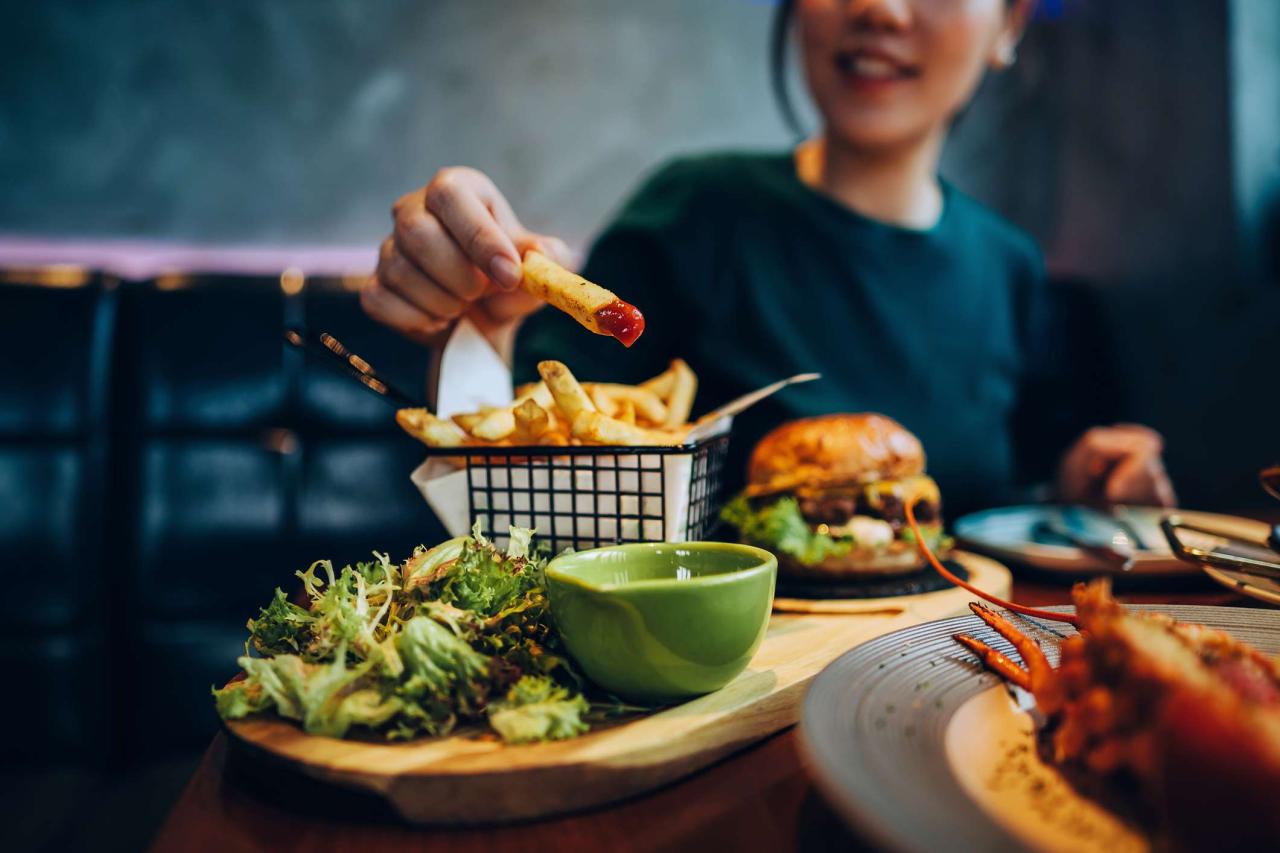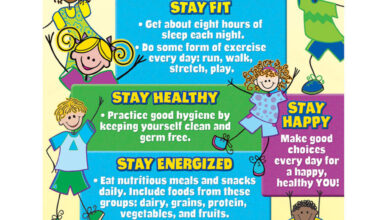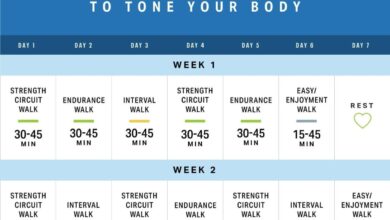
8 Ways to Quit the Clean Plate Club
8 Ways to Quit the Clean Plate Club – a phrase that might sound familiar, right? We’ve all been there, feeling obligated to finish everything on our plate, even when we’re full. This ingrained habit, often stemming from childhood, can lead to overeating, discomfort, and a strained relationship with food.
But fear not, there’s a better way! Let’s explore a mindful approach to eating that celebrates our bodies’ signals and fosters a healthier, happier relationship with food.
This journey starts with recognizing and honoring our body’s cues, learning to differentiate between true hunger and other triggers. We’ll delve into the power of mindful eating, where we savor each bite and connect with our food. Portion control, embracing leftovers, and challenging the “waste not, want not” mentality are all part of this mindful approach.
We’ll also discover the benefits of slowing down our eating pace, embracing a diverse and balanced diet, and ultimately reframing our relationship with food.
Listen to Your Body’s Signals

The clean plate club mentality often leads to overeating, ignoring your body’s natural hunger and fullness cues. Recognizing these signals is crucial for achieving a healthy relationship with food and breaking free from the habit of finishing everything on your plate.
Understanding your body’s cues allows you to eat mindfully, ensuring you consume the right amount of food for your body’s needs. This helps prevent overeating and promotes better digestion and overall well-being.
Recognizing Hunger and Fullness Cues
Becoming more aware of your body’s signals requires paying attention to physical sensations. These signals can be subtle, so it’s essential to tune in and learn to differentiate between true hunger and other triggers.
Quitting the clean plate club isn’t just about willpower, it’s about learning to listen to your body’s cues. Making small changes to your eating habits can make a big difference. For example, incorporating mindful eating techniques, like chewing slowly and paying attention to your hunger and fullness levels, can help you avoid overeating.
And, if you’re struggling with the concept of “enough,” check out this article on 10 Simple Changes That Lead to Weight Loss , which offers helpful tips on building healthier habits. Once you’ve mastered these fundamentals, you’ll be well on your way to breaking free from the clean plate club and creating a more mindful relationship with food.
- Hunger:A genuine feeling of hunger is often accompanied by a rumbling stomach, a slight headache, and a decrease in energy levels. It’s a gradual sensation that builds up over time.
- Fullness:Conversely, feeling full is a gradual process that starts with a sense of satisfaction and contentment. As you eat, you might experience a feeling of tightness in your stomach, a slight discomfort, or a decrease in appetite.
Strategies for Becoming More Attuned to Your Body’s Signals
Developing a greater awareness of your body’s signals requires practice and patience. Here are some strategies to help you become more attuned:
- Eat Mindfully:Focus on your food and pay attention to the flavors, textures, and aromas. Put down your phone or distractions and savor each bite.
- Check In Regularly:Throughout your meal, pause and assess your hunger and fullness levels. Ask yourself: “Am I still hungry?” or “Am I feeling comfortably full?”
- Listen to Your Body:Don’t ignore the signals your body is sending. If you feel full, stop eating, even if there’s food left on your plate. Don’t force yourself to finish it.
- Practice Patience:It takes time to develop a strong connection with your body’s cues. Be patient with yourself and don’t get discouraged if you don’t notice immediate results.
Practice Mindful Eating: 8 Ways To Quit The Clean Plate Club
Mindful eating is a powerful tool for breaking free from the clean plate club. It involves paying full attention to your food and the experience of eating, without distractions. This helps you become more aware of your body’s hunger and fullness cues, leading to healthier eating habits.
The Importance of Focused Eating
Mindful eating encourages you to savor each bite, appreciating the flavors, textures, and aromas of your food. By focusing on the present moment, you become more aware of your body’s signals, recognizing when you’re truly hungry and when you’re satisfied.
This awareness can help you avoid overeating, as you’re more likely to stop when you’ve reached a comfortable level of fullness.
Distractions and Overeating, 8 ways to quit the clean plate club
Distractions while eating can significantly contribute to overeating. When you’re watching TV, working on your computer, or scrolling through social media, you’re not fully present with your food. This can lead to mindless eating, where you consume more than you need without realizing it.
Mindful Eating Exercise
Here’s a simple exercise to help you practice mindful eating:
- Choose a meal or snack: Select a food you enjoy and find a quiet place to eat. Turn off your phone and any other distractions.
- Observe your food: Before taking a bite, take a moment to observe your food. Notice its color, shape, and texture. Inhale its aroma.
- Take small bites: Eat slowly and savor each bite. Chew thoroughly and pay attention to the flavors and textures.
- Listen to your body: Notice how your body feels as you eat. Are you feeling satisfied? Are you starting to feel full?
- Pause and reflect: Take a moment to pause between bites and reflect on how your food tastes and how your body feels.
- End your meal: When you feel comfortably full, stop eating. You can always have more later if you’re still hungry.
Portion Control
The clean plate club is often associated with finishing everything on your plate, regardless of how much food is served. While this may seem like a good way to avoid food waste, it can actually lead to overeating and weight gain.
Quitting the clean plate club isn’t just about willpower, it’s about learning to listen to your body’s signals. One key is to fill up on foods that keep you feeling full for longer, like those packed with fiber. Check out this guide for High Fiber Meals for Weight Loss: A Guide to Feeling Full and Slim and discover how incorporating fiber-rich foods can help you conquer those clean plate urges.
With the right strategies and a little knowledge, you can say goodbye to mindless eating and hello to a healthier, more mindful relationship with food.
Portion control, the practice of consuming appropriate amounts of food, plays a crucial role in maintaining a healthy weight and overall well-being. It helps you consume the right amount of calories and nutrients, preventing overindulgence and promoting a balanced diet.
Portion Sizes: Understanding the Basics
Portion sizes are standardized measures of food, offering a visual guide to appropriate serving amounts. These sizes are designed to meet your body’s nutritional needs without exceeding them. Understanding portion sizes allows you to make informed choices about how much food you consume at each meal.
Examples of Common Portion Sizes
- Meat:A portion of meat is roughly the size of a deck of cards. This applies to grilled chicken, steak, fish, or other protein sources.
- Vegetables:One cup of vegetables is considered a standard portion. This can be a cup of raw vegetables, such as broccoli or carrots, or a cup of cooked vegetables, such as spinach or green beans.
- Fruit:A medium-sized fruit, like an apple or banana, constitutes a typical portion. This also applies to a cup of berries or a half-cup of dried fruit.
- Grains:A half-cup of cooked grains, such as rice, pasta, or quinoa, is a standard serving size. This can also be one slice of bread or a small tortilla.
- Dairy:A single serving of dairy is one cup of milk, yogurt, or a small container of cottage cheese. This can also be a slice of cheese or a small scoop of ice cream.
Comparing Standard Portion Sizes with Typical Servings
| Food Group | Standard Portion Size | Typical Serving Size |
|---|---|---|
| Meat | 3 ounces (size of a deck of cards) | 6-8 ounces |
| Vegetables | 1 cup | 1/2 cup |
| Fruit | 1 medium-sized fruit or 1/2 cup | 1 large fruit or 1 cup |
| Grains | 1/2 cup cooked | 1 cup cooked |
| Dairy | 1 cup milk or yogurt | 2 cups milk or yogurt |
Embrace Leftovers: A New Perspective

The clean plate club often stems from a fear of wasting food. But what if we reframed leftovers as a positive aspect of meal planning? Embracing leftovers can actually help us save money, reduce food waste, and even get creative in the kitchen.
Leftover Repurposing: Culinary Creativity
Leftovers are not just about eating the same thing again. They offer an opportunity to unleash your culinary creativity and transform yesterday’s dinner into a completely new dish. This approach not only reduces food waste but also adds variety to your meals.Here are some ideas for repurposing leftover ingredients:
| Leftover Ingredient | New Dish Idea |
|---|---|
| Roasted Vegetables | Vegetable frittata, soup, or salad topping |
| Cooked Chicken or Beef | Chicken salad sandwiches, tacos, or stir-fry |
| Pasta | Pasta salad, baked pasta casserole, or soup base |
| Rice | Fried rice, rice pudding, or breakfast porridge |
| Beans | Bean soup, chili, or veggie burgers |
“Leftovers are not just about eating the same thing again. They offer an opportunity to unleash your culinary creativity and transform yesterday’s dinner into a completely new dish.”
Challenge the “Waste Not, Want Not” Mentality
The clean plate club often stems from a deeply ingrained desire to avoid waste. We’ve been taught from a young age that throwing away food is wrong and that we should always finish what’s on our plates. While this sentiment is rooted in good intentions, it can lead to overeating and potentially contribute to unhealthy eating habits.
Alternative Perspectives on Food Waste
The “waste not, want not” mentality, while admirable, needs to be re-examined in the context of modern food production and consumption. Food waste is a significant environmental issue, contributing to greenhouse gas emissions and depleting natural resources.
- According to the Food and Agriculture Organization of the United Nations (FAO), approximately one-third of all food produced for human consumption is lost or wasted globally.
- Food waste contributes to methane emissions, a potent greenhouse gas that is far more harmful to the environment than carbon dioxide.
- The production and transportation of wasted food also consume significant amounts of energy and water, further impacting the environment.
Therefore, while reducing food waste is important, focusing on finishing every plate, regardless of fullness, might not be the most effective solution. A more sustainable approach involves mindful consumption and reducing food waste at all stages of the food supply chain.
Quitting the clean plate club isn’t just about willpower, it’s also about understanding your body’s signals. Learning to listen to your hunger cues and stop eating when you’re satisfied, not stuffed, is crucial. It’s also helpful to remember the role of hormones in weight management, and how they can influence your appetite and metabolism.
Check out this article on 3 Hormones to Keep in Mind for Weight Loss to learn more. This knowledge can help you make informed choices about your diet and lifestyle, which in turn can help you break free from the clean plate habit and achieve your weight goals.
Practical Solutions for Reducing Food Waste
- Plan your meals and shop accordingly:This helps avoid impulse purchases and reduces the likelihood of food spoiling in your refrigerator.
- Store food properly:Understanding the best storage methods for different types of food can significantly extend their shelf life.
- Use leftovers creatively:Instead of discarding leftovers, get creative and transform them into new dishes.
- Compost food scraps:Composting helps reduce landfill waste and provides nutrient-rich soil for gardens.
- Support initiatives that combat food waste:Organizations like Food Recovery Network and gleaning programs work to collect and distribute excess food to those in need.
By adopting these practices, we can move away from the “waste not, want not” mentality and embrace a more sustainable approach to food consumption.
Slow Down Your Eating Pace

The speed at which you consume your meals can significantly impact your eating habits and overall health. Eating quickly can lead to overeating, as your brain doesn’t have enough time to register feelings of fullness. Conversely, slowing down your eating pace allows for better digestion, promotes satiety, and helps you develop a healthier relationship with food.
The Connection Between Eating Speed and Food Intake
Research indicates a strong correlation between eating speed and the amount of food consumed. Studies have shown that individuals who eat quickly tend to consume more calories than those who eat slowly. This is because the brain takes about 20 minutes to register feelings of fullness.
When you eat quickly, you may consume more food before your brain can signal that you’re satisfied.
Techniques for Promoting Mindful Eating and Slowing Down Mealtimes
To cultivate mindful eating and slow down your eating pace, consider implementing these techniques:
- Put Down Your Utensils Between Bites: This simple act forces you to pause and savor each bite, allowing your brain to register the flavors and textures of your food.
- Engage in Conversation: Talking with others during meals can naturally slow down your eating pace. Engaging in conversation allows you to focus on the present moment and savor the experience of eating.
- Chew Thoroughly: Aim for at least 20 to 30 chews per bite. This allows for better digestion and helps your body extract more nutrients from your food.
- Practice Mindful Breathing: Taking deep breaths during your meal can help you relax and focus on the present moment. This can also promote a sense of calm and reduce stress, which can often lead to overeating.
- Eliminate Distractions: Turn off the TV, put away your phone, and create a peaceful and relaxing environment for your meals. Distractions can lead to mindless eating and prevent you from fully appreciating your food.
Embrace Variety and Balance
Imagine a world where every meal is a symphony of flavors and textures, a vibrant tapestry of colors, and a satisfying journey for your taste buds. This is the power of embracing variety and balance in your diet, a crucial step in conquering the Clean Plate Club.
By incorporating a diverse range of foods into your meals, you’re not just satisfying your palate but also fueling your body with essential nutrients and maximizing your chances of feeling truly satisfied.
The Importance of a Diverse Diet
A diverse diet, rich in various food groups, plays a vital role in achieving satiety. Here’s why:* Nutrient Density:Different foods offer unique combinations of vitamins, minerals, and fiber, contributing to overall health and well-being.
Metabolic Boost A varied diet keeps your metabolism active, ensuring your body burns calories efficiently and prevents plateaus.
Improved Gut Health Fiber-rich foods, particularly those from diverse sources, support a healthy gut microbiome, which plays a crucial role in digestion, immunity, and overall health.
A Balanced Plate: The Key to Avoiding Overeating
A balanced plate, incorporating all essential food groups, is a visual representation of a healthy and satisfying meal. Here’s how it works:* Protein:Provides building blocks for muscles, tissues, and hormones, promoting satiety and keeping you feeling full longer. Examples include lean meats, poultry, fish, beans, lentils, and tofu.
Carbohydrates Provide energy for daily activities, supporting brain function and overall well-being. Opt for complex carbohydrates like whole grains, fruits, and vegetables, which are rich in fiber and digest slowly, contributing to a sense of fullness.
Healthy Fats Essential for hormone production, cell function, and absorption of certain vitamins. Choose unsaturated fats from sources like avocados, nuts, seeds, olive oil, and fatty fish.
Fruits and Vegetables Packed with vitamins, minerals, fiber, and antioxidants, contributing to a healthy immune system, vibrant skin, and overall well-being. Aim for a variety of colors and textures to maximize nutrient intake.
Remember:A balanced plate doesn’t have to be complicated. It’s about creating a harmonious blend of different food groups, ensuring you get the nutrients you need while satisfying your hunger.
Reframe Your Relationship with Food
The clean plate club mentality often stems from a deeper issue: a strained relationship with food. Moving beyond this mindset requires cultivating a healthier connection with food, one that prioritizes mindful eating, self-compassion, and joy.
Self-Compassion and Avoiding Food Guilt
Self-compassion is crucial in this process. Often, we judge ourselves harshly for not finishing a meal, leading to feelings of guilt and shame. This can create a negative cycle, further fueling the clean plate club mentality. Instead, practice self-kindness and understanding.
Recognize that your body has its own signals and needs, and it’s okay to listen to them.
- Acknowledge Your Feelings:If you feel guilty for leaving food on your plate, take a moment to acknowledge those feelings without judgment. Remind yourself that it’s okay to listen to your body’s signals.
- Shift Your Perspective:Instead of focusing on what you “should” eat, focus on what your body needs and enjoys. Remember, eating is about nourishment and pleasure, not punishment.
- Practice Gratitude:Appreciate the food you have, even if you don’t finish it all. Focus on the flavors and textures, and be thankful for the nourishment it provides.
Finding Joy and Satisfaction in Eating
A healthy relationship with food is about finding joy and satisfaction in eating, not obligation. This means focusing on the experience of eating itself, savoring the flavors, and appreciating the nourishment it provides.
- Mindful Eating:Pay attention to the food you’re eating, its taste, texture, and aroma. Engage all your senses and savor each bite.
- Slow Down:Take your time with your meals. Put down your utensils between bites, chew thoroughly, and allow yourself to fully experience the food.
- Choose Foods You Enjoy:Don’t force yourself to eat foods you don’t like. Instead, focus on choosing foods that you find satisfying and enjoyable.
Concluding Remarks
Quitting the clean plate club is not about deprivation, it’s about liberation. It’s about listening to your body, respecting its signals, and enjoying food without feeling obligated to finish every last bite. By embracing these mindful practices, you’ll cultivate a healthier relationship with food and find a deeper sense of satisfaction and joy in the act of eating.
Remember, it’s a journey, not a destination, and every step you take towards mindful eating is a step towards a happier, healthier you.






